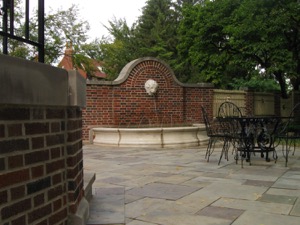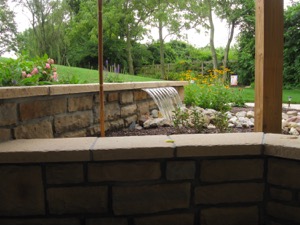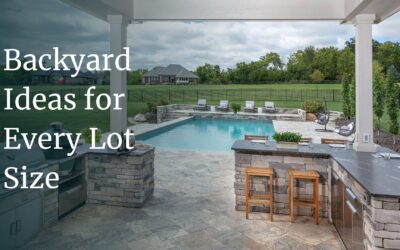Dave Swearingen, Landscape Architect with The Site Group, Inc. of New Carlisle, Ohio, answers some FAQs about landscape design and installation.
 Q. How much should I spend on my landscaping?
Q. How much should I spend on my landscaping?
A. This one really depends on several factors: How much do you enjoy landscaping? Are you concerned with exceeding the “maximum resale value” of your home? What are your outdoor entertaining needs? Many customers tell me, “we know that we may be overspending for our neighborhood, but we are planning on enjoying our yard, patio, etc. for the next several years, so that takes priority over resale value.” If you admittedly do not enjoy maintaining your yard and do not want to hire out the work (which is, by the way, probably more affordable than you think!), you should look into something simpler that will not require as much maintenance.
Generally speaking, your walks, patios, and landscaping should be 10-15 percent of the value of your home. If you don’t exceed neighborhood values, you should be able to at least get a 1:1 return on landscape investment, while obviously beautifying your home and adding curb appeal.
Q. What’s the difference between and landscape architect and a landscape designer?
A. A landscape designer may or may not have college education. Some designers have horticulture or landscape contracting education, but many excellent designers are “self-taught” and have great experience and skills.
A registered landscape architect in the state of Ohio must have a professional degree in landscape architecture (4-5 years of undergrad or 2-3 years of graduate school), three years of internship under the direction of another registered landscape architect, and have passed a three day exam. Does this mean they are a good designer? No!! Just like other fields, a degree and a license does not guarantee that someone can successfully solve the problems around your house. Do your research or get a referral from an architect, interior designer, or builder. These professions work around landscape designers and landscape architects every day and can tell you which ones would be best suited for your needs. Each firm or individual has a specialty, from residential design/build to campus planning to park design to public art. Take a closer look at the individual and/or firm you are hiring to make sure they are qualified to take on your project. Also, make sure your personalities mesh!!
 Q. Why should I pay a design fee?
Q. Why should I pay a design fee?
A. Like any other professional, landscape architects and designers are selling you their time, expertise, and experience. The old adage “you get what you pay for” really holds true in this circumstance. Most seasoned designers should be able, however, to give you some rough ballpark of the potential cost of the overall project at the first meeting; so ask!! An architect friend of mine likes to say, “There are three things that can be controlled in a project: size of spaces, budget, and detailing. Pick any two…” This is true also in the design market. If you want truly creative and custom ideas, you will have to pay for them. Along that same line of thought is the next question:
Q. How much will a plan cost?
A. This really depends on who you are buying the plan from. A consulting firm must make all of their money from design time, so hourly rates of $50-100 an hour are not uncommon. The advantage of this type of firm is that, theoretically, your project would be installed with exactly the same result by any qualified contractor. Many consultants offer some sort of construction oversight service so you can turn over installation questions and details to them. A design-build contractor will have opportunity to mark up materials and installation labor, so they may be willing to refund some of the design time cost toward the project installation. Typically their designs do not need to be as detailed, since they are using their own crews and would be responsible for communicating design intent during construction.
Q. I’m not sure how much I can afford to spend now – can you just do the front?
A. Sure, we can design any part of your project at any time. Generally, I like to encourage customers to get a conceptual master plan for the entire property. Get some rough ideas on paper for the entire “dream project” but only do what you can afford now. This will also introduce some ideas for future plans, for example, a shade structure that as you flip through design magazines you can look for different options for the detailing of this part of the plan. Then once future funds become available, you have ideas for fleshing out the rough master plan. Be careful, however, if you decide to do the front first, because you may have to tear part of it up with machines to access the back! It may be best to do the “heavy work” first, instead of thinking in terms of “front and back.”
Q. I’ve heard that you should always: ______________________
A. Fill in the blank here with “plant a shade tree on the south side” or “plant evergreens on the northwest side” or “not put mulch against the house” or “keep all plantings five feet away from the house (especially in the west for brush fires).”
While any or all of these rules of thumb can be fine, you are going to have to decide what your personal priorities are. In other words, if you lot has a great view out the northwest side, you may be willing to put up with some winter wind in order to accentuate that view. Each client, property, and project is unique, so you and your designer are going to have to work through your specific priorities. Another example: people tell me they want to attract birds and butterflies but not bees. Unfortunately, the same pretty blooms that bring hummingbirds and butterflies also attract bees, so you have to decide if you are willing to put up with one to get the other.
Q. Why does everyone use so many Stella d’ Oro Daylilies?
A. The quick answer: because they work! Stellas are easy to grow, have a long bloom season, and multiply rapidly.
The real issue, however, may be a lack of creativity of the designer, lack of customer knowledge for special care requirements of specific plants, or lack of willingness to give a plant time and care to let them mature and reach full potential. Let your designer know if you are a hobbyist and would like to try new, more exotic plantings. The general public is too often looking for a “one time fix” to gardening, but as with all living things, care along the way is needed! Look at your garden as a work in progress and realize that you may have to move some plants around to achieve optimum sun exposure, drainage, soil quality, etc. Or, just be happy with the “Stellas” of the landscape world: plants that look good, are easy to care for, and grow about anywhere.
For more information contact us today.




